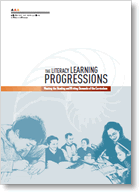You are here:
Understanding the literacy demands of the curriculum
Students need to do more than just read and write. They need to use their reading and writing to meet the demands of the New Zealand Curriculum. These demands are integral to many of the teaching and learning activities that support students in developing the key competencies as well as knowledge and skills in all the essential learning areas.
Reading and writing as interactive tools
Reading and writing are interactive tools1 that students use to engage with all the learning areas of the New Zealand Curriculum.
While some of the texts that students read and write are literary texts (which are almost always taught within the English learning area), others are texts integral to learning in other areas of the curriculum. These include texts such as information reports and procedural texts.
As language is central to learning and English is the medium for most learning in the New Zealand Curriculum, the importance of literacy in English cannot be overstated.
The New Zealand Curriculum, page 16
In the early years, most of the texts that students read or write within classroom contexts, largely by themselves, are part of their literacy instructional programme. As their literacy knowledge and skills develop, students increasingly use their reading and writing to meet specific learning purposes across the curriculum. From the middle years onwards, effective teachers systematically identify opportunities to strengthen students’ literacy expertise within a wide variety of curriculum learning activities. By the time students enter year 9, the reading and writing demands are implicit in much of their everyday curriculum learning.
The increasingly complex texts and tasks of the curriculum
As students move through the school system, the texts that they read and write and the tasks with which they must engage become increasingly complex. At the same time, the content (subject matter) that they read and write about becomes more abstract and specialised.
The reading and writing demands that the progressions describe were identified by analysing the achievement objectives for each learning area and also examples of the texts and tasks used in programmes designed to meet those objectives.2
A text’s complexity is affected by the kinds of information in it (the complexity of its content) and the ways in which that information is related and presented (the complexity of its structure and language). The characteristics that make texts more complex, and the main tasks for which the students need to use their reading and writing, are described in the The New Zealand Curriculum Reading and Writing Standards for Years 1–8. They are further explained in the professional learning materials provided online to support these standards.
1. The concept of interactive tools is based on the competencies model developed in the OECD project The Definition and Selection of Key Competencies (Organisation for Economic Co-operation and Development, 2005).
2. For example, the analysis included some exemplars from The New Zealand Curriculum Exemplars.


